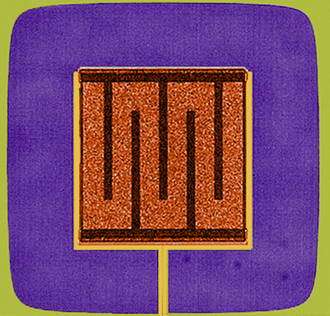Copper Ridges Nearly Double X-ray Sensor Performance

A series of copper ridges nearly doubles the resolution of experimental X-ray sensors, enabling more precise identification of the X-ray “fingerprints” of different atoms, researchers at the National Institute of Standards and Technology (NIST) report. The sensors are expected to be powerful tools for astronomy, such as in determining the temperature and motion of matter in space, and for semiconductor materials analysis, helping to differentiate between nanoscale contaminant particles on silicon wafers.
Image: The NIST "transition-edge sensor" is made of layers of molybdenum and copper with a coating of bismuth to increase the X-ray stopping power. The five copper ridges shown in this colorized photo enhance the sensor's performance. Image credit: NIST
The new design, described in the Nov. 7 issue of Applied Physics Letters,* can measure X-ray energies with an uncertainty of only 2.4 electron volts (eV), breaking through a long-standing 4.5 eV plateau in the performance of superconducting "transition edge" sensors (TES). The cryogenic sensors absorb individual X-rays and measure the energy based on the resulting rise in temperature. The temperature is measured with a bilayer of normal metal (copper) and superconducting metal (molybdenum) that changes resistance in response to the heat from the radiation. The new TES design performs about 40 times better than conventional X-ray sensors made of silicon and lithium.
The primary design change was the addition of five copper ridges patterned on the sensor, perpendicular to the current flow, which blunts or softens the change in resistance from superconducting to normal. NIST holds a patent on the sensor design concept.** The gentler transition reduces unexplained “noise” that degrades measurement precision. A second change was a reduction in device size from 400 to 250 micrometers square, which increases the rise in temperature caused by the X-rays, to better match the broader temperature range of the change in resistance.
NIST researchers expect to further improve sensor performance to reach the 2 eV resolution goal set by the National Aeronautics and Space Administration (NASA). NASA plans to mount TES sensors on a telescope sent into space on a satellite mission still under development. Improved sensor performance will enable scientists to better measure tiny shifts in X-ray frequency caused by the motion of atoms in space, for example. The latest NIST work was supported in part by NASA and the NIST Office of Microelectronics Programs.
* J.N. Ullom, J.A. Beall, W.B. Doriese, W.D. Duncan, L. Ferreira, G.C. Hilton, K.D. Irwin, C.D. Reintsema and L.R. Vale. 2005. Optimized transition-edge x-ray microcalorimeter with 2.4 eV energy resolution at 5.9 keV. Applied Physics Letters. Nov. 7.
** Superconducting transition-edge sensor with weak links, Hilton, Irwin, Martinis and Wollman, US6239431, Issued May 29, 2001.
Source: NIST















